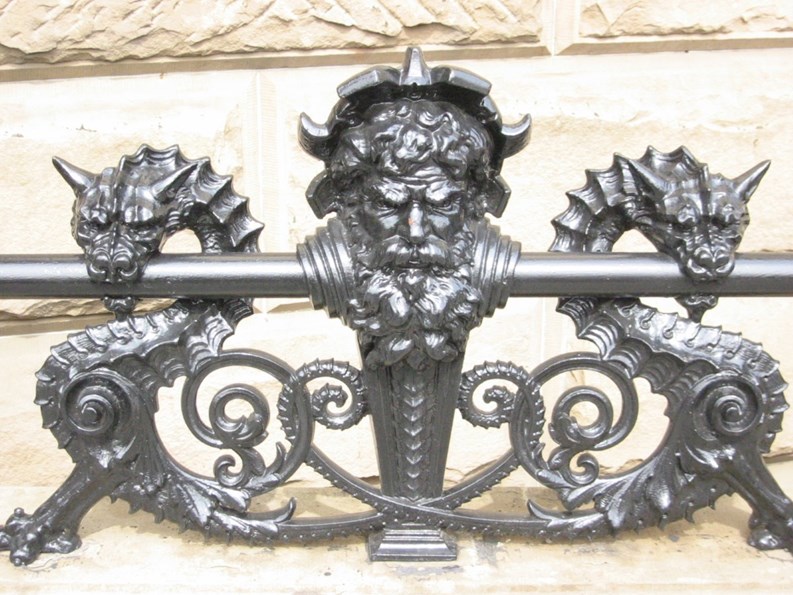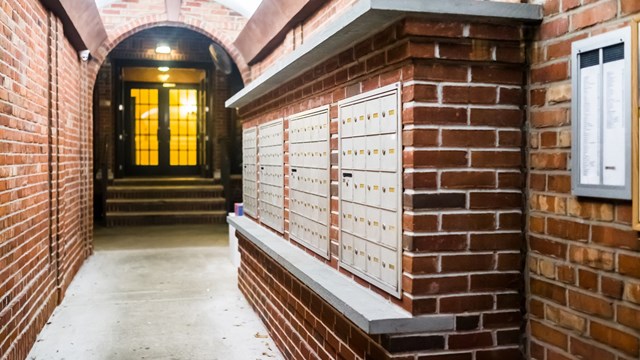New York City's condos and co-ops are more than just apartment buildings—they're part of one the most famous architectural landscapes in the world. Next time you walk around the city, slow down and notice the beautifully designed structures with stunning façades: you might see wrought-iron gates, some as old as 100 years, or decorative metal balconies. Take a look inside, and you're likely to walk across marble floors—some of them with ornate inlays—or an elevator with polished brass walls.
It all adds up to an often beautiful picture—but with all that beauty comes great responsibility. Failing to take proper care of decorative stone and metal in high-traffic residential spaces and structures can result in shoddy appearances and possibly even have a negative effect on apartment values.
"The entranceway is the first thing people see," says Peter Fidelman, vice president and general manager of sales and marketing for Long Island City's Remco Maintenance LLC, one of the largest metal/marble/stone/wood maintenance and refinishing companies in the city. "The value of those apartments, both in terms of the amount people are willing to pay as well as the number of offers one would have, certainly is affected [by the condition of metal in the lobby]."
According to Fidelman, his company maintains metals and stone in places like Grand Central Terminal, the Waldorf Astoria, Yankee Stadium's Monument Park and the Statue of Liberty. While you may not have thousands of tourists and commuters traipsing through your building every day, for residents your lobby and façade are just as important as those landmarks.
"If the values of apartments in buildings are $4 million and up, then one has to ask, what is the value of a lobby to support that value?" Fidelman asks. "What does it look like? And if the metalwork is not bright and not attractive and not rich, does it support a value of $4 million per apartment?"
Aesthetics and property values aside, buildings also have some safety and legal obligations to maintain their stone and façades in the form of Local Law 11, which requires most buildings with at least six stories to have their façades inspected on a regular basis.
So you have all the reasons you need to keep your decorative metal and stone clean, shiny and in good repair; now you just have to make sure you do it right.
Showing Your Metal
When asked to name some of the more popular metal architectural or design elements found in New York's buildings, Robert Coffey, Remco's manager of metal operations, cited copper, bronze, brass, stainless steel and aluminum. "These metals are all treated differently, depending on temperatures and location, or if the property is exposed to salt water," Coffey says.
When an architect designs a building the appearance is obviously kept in mind, though often without much regard for the maintenance of that appearance, says Fidelman. It's up to the building management to maintain the elements of a building, including exterior and interior metal and stonework finishes in both old and new buildings.
"Keeping that finish looking like it's still just been installed is really the goal of the building owner," Fidelman says. "And that's as true for a commercial building as it is for a prestigious residential dwelling."
Proper regular maintenance of decorative metals will, of course, keep things looking spiffy and prevent damage over the passage of time. The right maintenance plan for your building will depend on factors like what metals are found in your building and where they're located. For example, an elevator plate is going to get dirtied with fingerprints and handprints on a regular basis, while a brass lamp above the elevator might not be handled at all.
If your metals haven't been maintained, or have been maintained poorly, you should talk to a restorer about the level of damage, how it can be restored and how much that restoration will cost.
Set in Stone
According to Fidelman there are two major aspects of stone maintenance, whether the stone is indoors or out: attractiveness and compliance with regulations like Local Law 11.
According to Fidelman and Coffey, there are too many different types of stone incorporated into New York City's residential buildings to describe them all—and many of them require different processes and products to be kept clean and in good condition. Different types of stone wear differently and can be influenced by factors like location and exposure to wind or seawater. But there's one thing they all have in common.
"All stone will wear," says Fidelman. It will discolor, and it will show watermarks. And those things really need to be corrected."
Your building's façade may even be facing elements it wasn't previously because of new construction in the area.
"Because a new building was put up, it has now blocked, at certain elevations, your building," Coffey says. "Then, because the building isn't getting enough sunlight, there are all kinds of moisture problems."
The amount of new construction in Manhattan can even influence wind patterns, according to Coffey. "In Lower Manhattan, some of the buildings weren't there [until recently] and some of the older buildings have suffered because of change of winds and lack of sun," he says. "[They've started] to develop problems with corrosion and moisture."
Metal Maintenance
Using the wrong cleaners on the wrong metal can also cause damage, and your building's maintenance staff isn't qualified to repair scratches and other wear and tear, the process can accelerate. None of this is to say you need to call in a pro every time a railing loses its shine, but serious work on decorative metals should be left to experts.
"You can get building maintenance people to do what I'll call 'wipe-downs,' but when an untrained janitorial person tries to do more than that, the danger is they're actually wearing the metal or changing its finish," Fidelman says. "And certainly they don't have the ability to go deeper than that and do things like remove scratches or really protect the finish."
Coffey adds that permanent damage can occur if proper chemicals aren't used on each metal. Beyond that, buildings may be seeking a specific kind of look to these metals that an amateur may be unable to maintain. "We've just completed a few projects for clients who wanted metal installed that looked authentic and aged," says Coffey, adding that those types of custom finishes and patinas can be particularly hard to care for.
Wrought iron, for example, presents its own set of challenges. It's used for window guards, outdoor railings, fences and gates and is a classic component of New York City streetscapes. The good news is that once wrought iron is installed, buildings can pretty much maintain it themselves, says Larry Kaufman, president of J. Kaufman Iron Works, a Paterson, New Jersey-based company that has manufactured decorative ornamental iron and window guards since 1907.
"The maintenance on wrought iron is typically scraping and painting, and most of these buildings have staff or painters who do it less expensively than us," Kaufman says, adding that more often his company is hired to install or repair iron elements. "We get involved when something is broken or has rotted because it hasn't been maintained…or if it has to be replaced," he says.
Like most things, regular maintenance will keep wrought iron healthy and attractive. Factors like weather and location can impact the damage done to wrought iron, Kaufman says, but annual cleanings and paintings should keep it looking good "forever."
"The main problem with wrought iron is rust," he says. "If you paint it and if you maintain it regularly, and you stay on top of it, you see wrought iron in front of buildings that could be 50 or 100 years old. Let it rust and it starts to corrode, you're done."
An Inside Job
The amount of maintenance needed for a marble floor or indoor brass, on elevators for example, can vary based on a building's size, the amount of people who live there and the desires of the building's community. Lina Gottesman, who has owned Altus Metal & Marble in St. James since 1989, says buildings should have a regular schedule for maintaining marble floors, or brass in an elevator.
"It all depends on the type of building you're in and what the requirements are for that building," she says. "I do some very small condos and I've done some of the very large, very elaborate fancier condos where the clientele expects to see a shiny door and a shiny elevator. They like to see their floors nice and polished all the time. The needs of the building affect how often we actually do the work."
Gottesman says her company generally refinishes metals like brass once a year. Brass in an elevator may be cleaned twice a year based on traffic.
"We have quarterly services where we come in, clean it up and touch up some areas every three months depending on how much traffic you have in the building," she says.
Marble floors may be done from once a year to up to four times a year depending on a building's budget and needs. But having them cleaned regularly is important, Gottesman says, and not just for aesthetics.
"When you keep a marble floor polished, it's as if you're putting a natural sealer across the top," she says. "You're not putting any product there, but the actual process of grinding the floor down to a high polish actually seals the stone so that it's less vulnerable to dirt or spills."
Making (or Maintaining) History
Buildings that feature statues or gargoyles in their façades take a different set of skills to maintain than a typical brick façade, according to Fidelman.
"It's done more delicately, more finely and we have a different set of craftsmen for that sort of work," he says. When historic buildings are worked on, their look has to be preserved, and the work needs to be approved by the Landmarks Preservation Commission, among other city agencies.
But in many ways all these stones are also equal in that they need to be treated the proper way or serious damage to the structure is a risk. Fidelman says a recent client required major work because a previous company hadn't maintained the stone properly, so he had to explain to the building's management why the job became so involved.
"The reason was another company had not understood the nature of the process they [used] and the materials they were using to seal it," he says. "And the sealer had basically come off and dirt and grime—and in this case grease—had penetrated very deeply into the stone."
Fidelman says that foremen who repair buildings can recognize different stones and what treatments to use. Professionals in the industry work to keep up with new developments, including new maintenance products, to keep the city's stone and metal up-to-date.
"We do have to learn about the latest technologies when it comes to these materials so that they don't cause any damage," Fidelman says. "Unfortunately [buildings] find out the hard way by going cheaper than they should have and they find out material can't be treated."
Anthony Stoeckert is a freelance writer living in Bordentown, New Jersey.







Leave a Comment